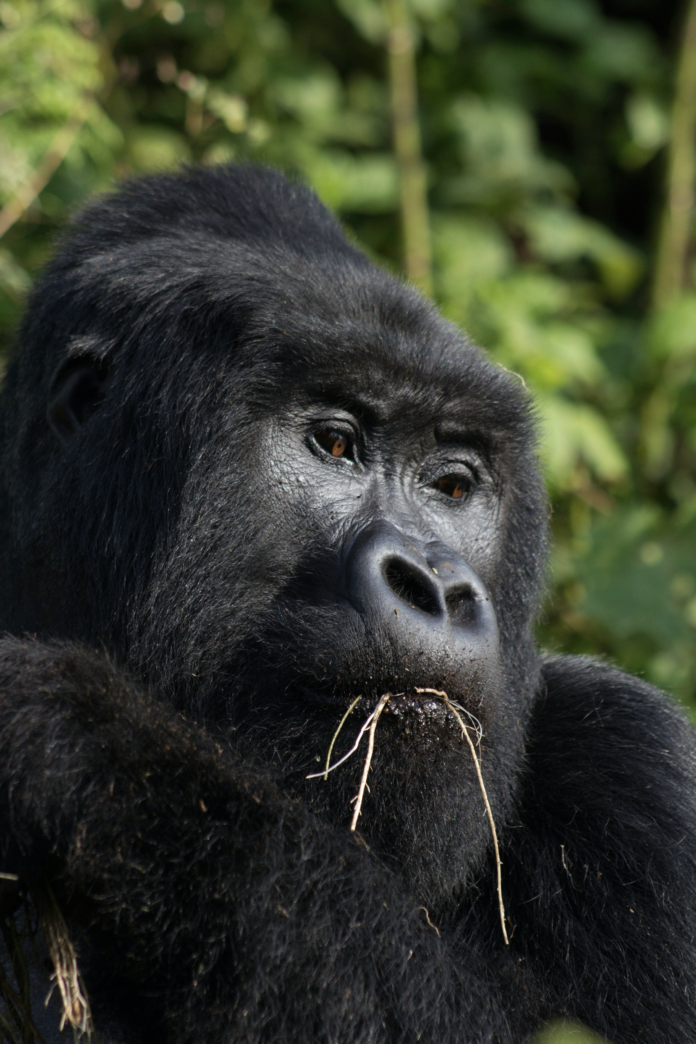Researchers at UC Davis use chewed plants to test gorillas for human viruses
By LILLY ACKERMAN— science@theaggie.org
A recent study by faculty at UC Davis School of Veterinary Medicine’s One Health Institute has found no evidence of human herpesviruses (human HSV-1) in mountain gorilla populations. The study did, however, find a new noninvasive sampling technique, the first of its kind used to definitively test for disease in mountain gorilla saliva.
The saliva sampling technique was introduced by Dr. Tierra Smiley Evans, the lead author of the study and a Ph.D. veterinarian researcher at the One Health Institute and Wildlife Health Center (WHC) at UC Davis. The method involves extracting the saliva contained in mouthfuls of chewed up plants that gorillas discard and testing it for a variety of diseases. In this case, Evans and her team tested the samples for human herpesviruses, which pose concerns to wild gorilla populations.
“I think what’s really exciting about this method is that it can be done entirely noninvasively, and you don’t need to interrupt [the gorillas’] daily activities at all,” Evans said.
The saliva in chewed plants is collected without direct gorilla contact as opposed to a blood or saliva sample, which has to be taken directly from the animal after anesthesia. This method not only keeps human disruption to the animals low, but it also keeps any disease transmission risk to a minimum.
Since 2009, UC Davis’ WHC has been partnered with the Mountain Gorilla Veterinary Project, an organization dedicated to the conservation of mountain gorillas in Central Africa. Their collaboration, known as Gorilla Doctors, was created with the goal of monitoring and providing veterinary care to mountain gorillas.
Remaining mountain gorilla populations are small and have been habituated to human presence because of research, ecotourism and gorilla trekking. These qualities have been helpful to the veterinarians in the Gorilla Doctors, as they allow them to offer the gorillas individualized care and closely monitor the populations for diseases.
“We know the individual [gorilla], and we have a biospecimen from them, which is really unique for a lot of endangered species,” Evans said. “[It] allows us to do some pretty cool stuff.”
Mountain gorillas are an endangered species, limited to only small ranges in Rwanda, Uganda and the Democratic Republic of the Congo (DRC), according to Evans. They live in biodiverse forests, so they have a wide variety of vegetation to choose from for a tasty bite. Much of their day is spent eating the fleshy parts of plants and discarding chewed-up piles of remains that they dislike.
One gorilla’s trash is a researcher’s treasure though. Evans and the Gorilla Doctors team would wait nearby for these piles to be dropped as the gorillas continued their quests for food. When a gorilla had moved on to another plant, the veterinarians collected the discarded mouthful and recorded the identity of the gorilla that discarded it.
Using this technique, Evans and staff at Gorilla Doctors were able to test remaining populations of mountain gorillas for human herpesviruses. Fortunately, the study found no evidence of human HSV-1 in the species.
“Our results indicate that wild mountain gorilla populations were not infected with human HSV-1 at the time of sample collection, despite known frequent direct contact between mountain gorillas and humans,” the study reads.
Dr. Kirsten Gilardi, the executive director of Gorilla Doctors, director of UC Davis’s WHC and co-author on the study, discussed the value of the chewed plant method for future use in gorilla research and conservation.
“We don’t need any more evidence to know that this is a perfectly viable method for us to use,” Gilardi said. “I anticipate that it’s now going to be a standard tool that we can use going forward.”
While even the most common viruses to humans, such as some herpesviruses, may not be a threat to the human population, they can be lethal to gorillas. Due to the problems that could ensue if a mountain gorilla were infected with a human virus, close monitoring and testing is not the only measure in place to prevent an outbreak among the population.
“Recognizing that habituating great apes puts them uniquely at risk for potentially getting a disease from a human, great ape sites around the world have adopted best practices around being near [them],” Gilardi said.
These practices include keeping a minimum distance away from gorillas, designating specific eating areas within visitation sites and wearing masks near gorillas, which has been more widely enforced since the start of the COVID-19 pandemic.
With the Gorilla Doctors’ efforts and the chewed plant technique, Evans echoed sentiments of optimism towards the future for the conservation of the wild mountain gorilla population in Central Africa.
“As a result of Gorilla Doctors’ work, mountain gorillas have actually increased in numbers,” Evans said. “The most exciting thing for me is probably seeing the positive impacts of conservation and this kind of work. The mountain gorillas really are a positive story.”
Written by: Lilly Ackerman— science@theaggie.org




